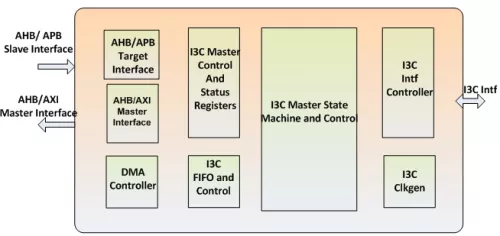The MIPI I3C interface is an evolutionary standard that improves upon the features of I2C, while maintaining backward compatibility. This standard offers a flexible multi-drop interface between the host processor and peripheral sensors to support the growing usage of sensors in embedded systems.
The main purpose of MIPI I3C is threefold:
To standardize sensor communication
Reduce the number of physical pins used in sensor system integration and
Support low-power, high-speed and other critical features that are currently covered by I2C and SPI.
I3C Host Controller
Overview
Key Features
- Compliant with MIPI I3C Specification V1.0
- Compliant with MIPI I3C HCI Specification V1.0
- Supports up to 12.5 MHz operation using Push-Pull
- Open-Drain and Push-pull type transactions (as required)
- Supports legacy I2C devices
- Dynamic Addressing while supporting Static Addressing for Legacy I2C devices
- Legacy I2C Messaging
- I2C-like Single Data Rate Messaging (SDR)
- Optional High Data Rate Messaging Modes (HDR)
- Support for Multi-host (transferring the ownership of the bus to a Secondary Host if Present)
- Reception of In-band Interrupt Support from the I3C Slave devices
- Reception of Hot-Join from newly added I3C Slave devices
- Synchronous Timing Support and Asynchronous Time Stamping.
- APB/AHB Target Interface for Configuring/Controlling the IP with Interrupt output
- Small 16-byte (Configurable) FIFO for transferring data between Host and the Device
- Independent Clocks for AHB and the I3C Interface
Block Diagram

Deliverables
- RMM compliant synthesizable RTL design in Verilog
- Easy-to-use test environment
- Synthesis scripts
- Technical documents
- Validated with 3rd Party UVM-based Slave VIP and available as an additional option
Technical Specifications
Maturity
Silicon proven
Availability
NOW